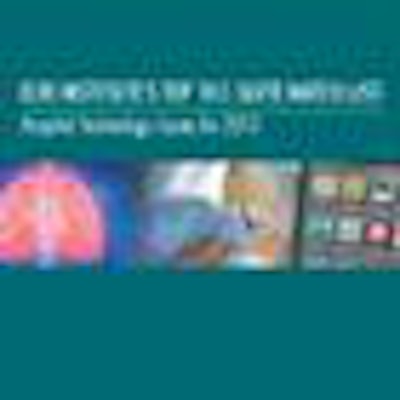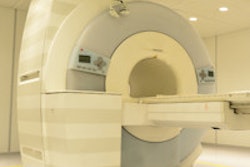
For the second year in a row, topics related to medical imaging dominated the annual top 10 list of important technology issues for hospital executives, from the perspective of nonprofit technology research firm ECRI Institute.
ECRI's "Top 10 C-Suite Watch List," now in its third year of publication, is designed "to identify technologies used in clinical care that will potentially change care, workflow, and/or operations widely and that healthcare leaders should keep an eye on," according to the report.
This year's list, derived from ECRI's team of technology experts and its associates who monitor hospital and healthcare organizations, is as follows:
- Electronic health records (EHRs)
- Mobile health (mHealth)
- Alarm integration technology
- Minimally invasive cardiac surgery
- Imaging and surgery
- PET/MR
- Bariatric surgery
- Supply chain
- Radiation dose safety
- Lung cancer screenings
The list has some notable changes compared to last year -- but also some similarities. To no surprise, EHR technology was the top concern cited in both 2012 and 2013.
However, several medical imaging technologies that were prominent in 2012 fell off this year's list completely, including digital breast tomosynthesis (ranked No. 3 in 2012), ultrahigh-field MRI (No. 8 last year), and proton beam radiation therapy (No. 10 in 2012).
New CT radiation reduction technologies (No. 4 in 2012) morphed into a more general category of radiation dose safety, coming in this year at No. 9. Lung cancer screening is a new addition, as is the category of imaging and surgery.
The report's findings on healthcare IT and radiology-related topics are summarized below.
No. 1: Electronic health records
In the report, ECRI expresses concern about maintaining healthcare IT safety, noting that hospitals rushed to meet stage 1 meaningful use requirements, and "are now sprinting toward stage 2" to qualify to receive financial reimbursement from the federal government for adopting electronic medical records.
In 2012, ECRI's Patient Safety Organization conducted an analysis of healthcare IT-related safety events, and found that HIT has introduced a whole new set of problems for patient safety.
Even more worrisome, hazards may be invisible to hospitals. ECRI recommends using a systems approach to assess the root causes of HIT safety problems and their potential solutions. In addition to implementing HIT-related patient safety programs, ECRI strongly recommends that a culture of safety be implemented and reinforced with anyone who uses any healthcare IT system within and interfacing with the hospital.
No. 2: mHealth
Mobile devices of every type are becoming ubiquitous in hospitals to collect, monitor, and deliver healthcare information. But does mHealth technology really improve healthcare processes and efficiencies?
The report advises how mobile devices should be managed and optimized to improve communication among caregivers and with patients. For example, it mentions using mobile health technologies to increase clinical decision support, allowing a provider to interact with colleagues in real-time.
No. 5: Imaging and surgery
Once a novelty in the operating room (OR), PACS workstations, sterile keyboards, and display monitors are now considered indispensible for accessing and viewing patient images. This is also true for small mobile imaging devices.
Now, ECRI confirms a trend of hospitals adding hybrid operating suites that contain angiography systems, CT scanners, and MRI systems. These onsite modalities are used to guide high-risk minimally invasive surgery, combine open and minimally invasive surgery, and verify the successful completion of surgery before a patient is moved from the operating room.
Before jumping on the hybrid OR bandwagon, is this expensive investment in imaging modalities and architectural/structural modifications needed? Is the cost justified? Hospital executives should be realistic, conduct analyses, and if they decide to proceed, develop a comprehensive strategic plan, according to ECRI.
No. 6: PET/MR
ECRI urges caution to hospitals deciding whether to acquire a PET/MR system. Acknowledging that PET/MR provides the same functional imaging capabilities as PET/CT, the report notes that PET/MR shows better contrast for soft tissues.
Better images of soft tissue may help radiologists more accurately diagnose certain types of cancers, specifically those embedded in tissue-filled area. Additionally, patients are exposed to approximately 70% less ionizing radiation when imaged with a PET/MR scanner versus a PET/CT system.
But is this multimillion dollar investment and the cost of building or renovating space worth it? Not many facilities have an open space with the appropriate shielding requirements for both radiofrequency/magnetic fields and radiation.
The report includes questions that hospital executives should ask to determine if the facility they manage should invest in a PET/MR scanner.
No. 8: Supply chain (the effect of MR-compatible pacemakers on expenses)
The first MR-compatible pacemaker was introduced to the U.S. market one year ago -- the Revo MRI SureScan from Medtronic, according to the report. Although such pacemakers may have safety benefits, they could increase hospital costs "significantly" without any boost in reimbursement.
According to Medtronic, 50% to 75% of patients with an implantable cardiac device will need an MRI procedure during their lifetime; with that in mind, which patients should get the more expensive MRI-conditional pacemakers? The question is particularly salient as more devices approach the market.
Hospitals and health systems should "work closely with their value analysis programs" to develop the best clinical and financial decisions for their organization, the report states.
No. 9: Radiation dose safety
In its 2012 report, ECRI focused almost entirely on CT radiation dose reduction, whether by purchasing new CT scanners with new dose-reduction and dose-modification capabilities, or by having a radiology department implement protocols that optimize scanning parameters for patients. The report also promoted iterative reconstruction software, purchased as an option with a new CT scanner or from third-party vendors.
In the current report, ECRI still promotes CT technology that offers dose reduction and flexibility in imaging patients of various sizes. However, it also notes that radiation dose monitoring will become as important as radiation dose reduction in the foreseeable future.
ECRI recommends investing in dose-monitoring software, whether purchased with a modality or from a third-party vendor. The institute also cautions hospitals to verify before purchasing any product that radiation dose information can be exchanged with external information systems, such as an EHR.
In addition to participating in what it calls the "CT dose how-low-can-you-go limbo dance," hospitals must be proactive with respect to mandating ALARA (as low as reasonably achievable) imaging protocols for any radiation-emitting modality.
No. 10: Lung cancer screenings
Lung cancer screening programs for high-risk patients have been proliferating ever since the National Lung Screening Trial (NLST) found that low-dose CT screening of high-risk patients reduced mortality by 20%.
Should hospitals implement lung cancer CT screening? The concept is in its infancy as a clinical intervention. For this reason, hospitals need to assess if they have the volume of patients to support a program, and what needs to be done to implement and manage the program.
In addition to establishing guidelines, because the specificity of imaging is so low, facilities would need to establish and enact policies for interpreting and managing suspicious nodules.
In other words, do the research. If seemingly feasible, proceed with caution.



















